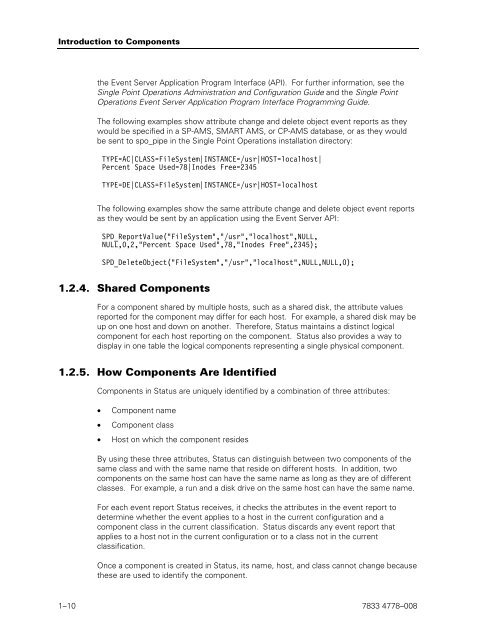Operations Sentinel Status User Guide - Public Support Login - Unisys
Operations Sentinel Status User Guide - Public Support Login - Unisys
Operations Sentinel Status User Guide - Public Support Login - Unisys
Create successful ePaper yourself
Turn your PDF publications into a flip-book with our unique Google optimized e-Paper software.
Introduction to Components<br />
the Event Server Application Program Interface (API). For further information, see the<br />
Single Point <strong>Operations</strong> Administration and Configuration <strong>Guide</strong> and the Single Point<br />
<strong>Operations</strong> Event Server Application Program Interface Programming <strong>Guide</strong>.<br />
The following examples show attribute change and delete object event reports as they<br />
would be specified in a SP-AMS, SMART AMS, or CP-AMS database, or as they would<br />
be sent to spo_pipe in the Single Point <strong>Operations</strong> installation directory:<br />
TYPE=AC|CLASS=FileSystem|INSTANCE=/usr|HOST=localhost|<br />
Percent Space Used=78|Inodes Free=2345<br />
TYPE=DE|CLASS=FileSystem|INSTANCE=/usr|HOST=localhost<br />
The following examples show the same attribute change and delete object event reports<br />
as they would be sent by an application using the Event Server API:<br />
SPD_ReportValue("FileSystem","/usr","localhost",NULL,<br />
NULL,0,2,"Percent Space Used",78,"Inodes Free",2345);<br />
SPD_DeleteObject("FileSystem","/usr","localhost",NULL,NULL,0);<br />
1.2.4. Shared Components<br />
For a component shared by multiple hosts, such as a shared disk, the attribute values<br />
reported for the component may differ for each host. For example, a shared disk may be<br />
up on one host and down on another. Therefore, <strong>Status</strong> maintains a distinct logical<br />
component for each host reporting on the component. <strong>Status</strong> also provides a way to<br />
display in one table the logical components representing a single physical component.<br />
1.2.5. How Components Are Identified<br />
Components in <strong>Status</strong> are uniquely identified by a combination of three attributes:<br />
• Component name<br />
• Component class<br />
• Host on which the component resides<br />
By using these three attributes, <strong>Status</strong> can distinguish between two components of the<br />
same class and with the same name that reside on different hosts. In addition, two<br />
components on the same host can have the same name as long as they are of different<br />
classes. For example, a run and a disk drive on the same host can have the same name.<br />
For each event report <strong>Status</strong> receives, it checks the attributes in the event report to<br />
determine whether the event applies to a host in the current configuration and a<br />
component class in the current classification. <strong>Status</strong> discards any event report that<br />
applies to a host not in the current configuration or to a class not in the current<br />
classification.<br />
Once a component is created in <strong>Status</strong>, its name, host, and class cannot change because<br />
these are used to identify the component.<br />
1–10 7833 4778–008
















